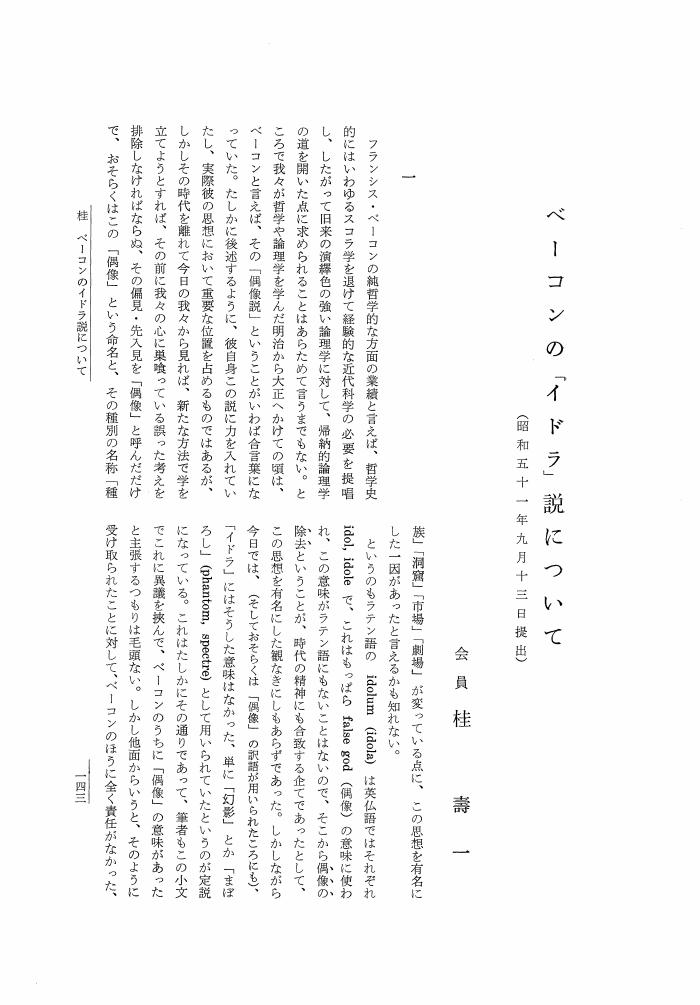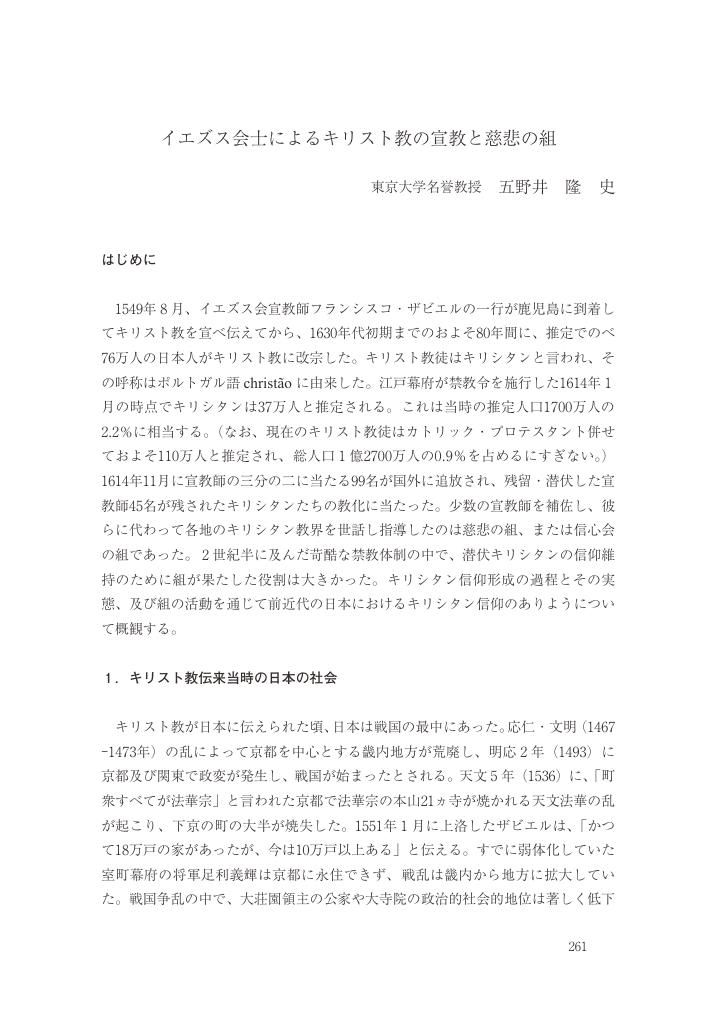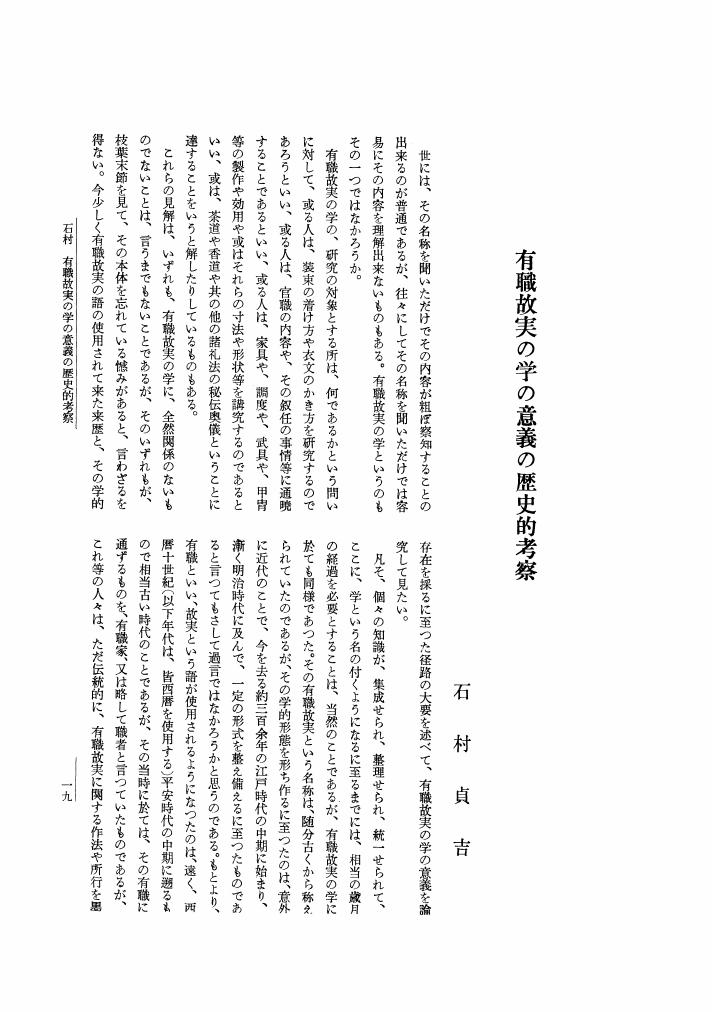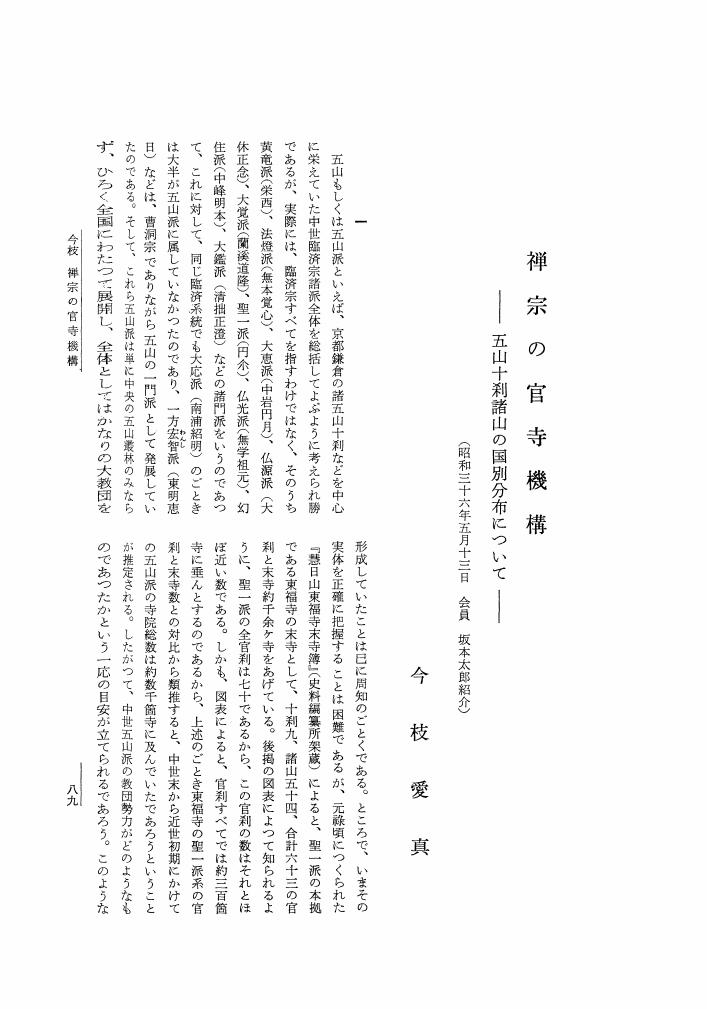4 0 0 0 OA 法が歴史を書く? : --最近のフランスの事例に即して--
- 著者
- 樋口 陽一
- 出版者
- 日本学士院
- 雑誌
- 日本學士院紀要 (ISSN:03880036)
- 巻号頁・発行日
- vol.62, no.2, pp.215-235, 2007-12
4 0 0 0 OA 行政法学における法人論の変遷 (平成一二年一二月一二日 提出)
- 著者
- 塩野 宏
- 出版者
- 日本学士院
- 雑誌
- 日本學士院紀要 (ISSN:03880036)
- 巻号頁・発行日
- vol.56, no.2, pp.49-64, 2002 (Released:2007-06-22)
It varies from country to country and era to era what kind of legal entities take upon public services such as supply of electricity and gas etc. and transportation of passengers and goods. At present, in Japan, the policy of leaving public services, in principle, to the market is being promoted. That is what is called privatization. However, as entities providing services in the market, in addition to the central and local governments, there exist legal entities which can be seen practically as a part of government. How to position these legal entities legally is an important task for the current scholarship on administrative organization law. This thesis analyses the historical process on the argument in the Japanese administrative law about the entities other than central and local governments, which provide public services.
3 0 0 0 OA 「買収プレミアム」と株式買取請求に係る「公正な価格」
- 著者
- 江頭 憲治郎
- 出版者
- 日本学士院
- 雑誌
- 日本學士院紀要 (ISSN:03880036)
- 巻号頁・発行日
- vol.77, no.3, pp.149-177, 2023 (Released:2023-05-12)
Ⅰ. Introduction In acquisitions of publicly traded companies, a “takeover premium” is usually paid to the shareholders of the target company, who are the sellers. If the consideration for the acquisition is cash, the acquirer makes a tender offer for the target company's shares, and the purchase price is often the market price of the target company's shares before the announcement of the acquisition plan plus an additional 30% or so, which is the takeover premium. If the consideration for the acquisition is shares issued by the acquirer (in the case of an acquisition through a merger or similar procedure), the merger ratio is often set in favor of the target company relative to the stock prices of the two companies before the announcement of the acquisition plan, which is the takeover premium. In a cash offer, the acquirer uses corporate law procedures to cash out shareholders who have not tendered their shares in the tender offer and remain in the target company, but the shareholders who are dissatisfied with the consideration delivered (which is the same amount as the purchase price in the tender offer) may petition the court to determine a “fair price” for the shares. In a merger or other acquisition in which shares are used as consideration, a shareholder who voted against the resolution approving the merger agreement may request the company to purchase his/her shares at a “fair price”. If the opposing shareholders and the company cannot reach an agreement on the purchase price, either party may petition the court to determine the purchase price. These rights are the appraisal rights. (View PDF for the rest of the abstract.)
3 0 0 0 OA 行政法における「公益」について : 公益法人制度改革を機縁として
- 著者
- 塩野 宏
- 出版者
- 日本学士院
- 雑誌
- 日本學士院紀要 (ISSN:03880036)
- 巻号頁・発行日
- vol.64, no.1, pp.25-50, 2009 (Released:2017-04-05)
3 0 0 0 OA 忘れられた歴史•地理学者北沢正誠 (昭和六十一年四月十四日 提出)
- 著者
- 岩生 成一
- 出版者
- 日本学士院
- 雑誌
- 日本學士院紀要 (ISSN:03880036)
- 巻号頁・発行日
- vol.42, no.1, pp.1-14, 1987 (Released:2007-06-22)
- 参考文献数
- 16
KITAZAWA was born to the family of a retainer of the lord Sanada of the Matsushiro fief in Shinano Province. He studied under Zozan SAKUMA in his youth and was much influenced by his teacher. After the Meiji Restoration, he obtained a position in the central government, representing the Matsushiro fief. After that, he entered the services of the Historiographical Bureau of Tokyo University, the Department of Foreign Affairs and so forth.In 1879 he made utmost efforts to establish the Tokyo Geographical Society, and since then, on the one hand he did much for its management and development, and on the other hand, devoted himself to the studies on history and geography, especially on those of Mongolia and Korea, which adjoin to China. Many papers and books, containing outstanding results of his studies concerning the said fields, were given to the public during that time.He acted as a headman of Koishikawa Ward and also as a government official of Ogasawara Islands. He was a teacher of Japanese literature and Chinese classics at Takada Middle School in his last several years and died in 1901.
3 0 0 0 OA 對稱變換ニ就テ (昭和十九年四月十二日報告)
- 著者
- 掛谷 宗一
- 出版者
- 日本学士院
- 雑誌
- 帝國學士院紀事 (ISSN:03879984)
- 巻号頁・発行日
- vol.3, no.3, pp.593-603, 1944 (Released:2007-05-30)
3 0 0 0 OA ベーコンの「イドラ」説について (昭和五十一年九月十三日提出)
- 著者
- 桂 壽一
- 出版者
- 日本学士院
- 雑誌
- 日本學士院紀要 (ISSN:03880036)
- 巻号頁・発行日
- vol.34, no.3, pp.143-150, 1977 (Released:2007-05-30)
3 0 0 0 OA 「立憲主義」と「憲法制定権力」 : 対抗と補完 : 最近の内外憲法論議の中から
- 著者
- 樋口 陽一
- 出版者
- 日本学士院
- 雑誌
- 日本學士院紀要 (ISSN:03880036)
- 巻号頁・発行日
- vol.69, no.3, pp.105-128, 2015 (Released:2017-04-05)
3 0 0 0 OA 天皇社会、武家社会、産業社会
- 著者
- 富永 健一
- 出版者
- 日本学士院
- 雑誌
- 日本學士院紀要 (ISSN:03880036)
- 巻号頁・発行日
- vol.71, no.3, pp.137, 2017 (Released:2017-04-13)
This is a study on the history of Japanese society based on three divisions, namely, the Ancient Stage, the Middle Stage, and the Modern Industrial Stage. As a country, Japan emerged during the fifth century under the name Yamato Chotei. Previously, it consisted of many small Uji and Kabane communities without the integrated and central control of Tenno domination under the name of “shiseisei”(氏姓制). It consisted of many small competing local areas, that fought incessantly between them. The important emperor Tenji Tenno(626–671), leader of the Taika-no-Kaisin , made a significant break to the traditional institution of the “shisei-sei” by introducing a new body that became known as “Handenshuju-sei”(班田収授制 in 律令制) in the year 645. The end result was the founding in 710 of the new capital Heijo-kyo in the city of Nara under the reign of Empress Genmei Tenno . However, the city of Nara was greatly affected by the sudden decision in 794 taken by Emperor Kanmu Tenno to make the city of Kyoto the country's capital. Although some may hold the view that there were similarities between the neighboring cities of Nara and Kyoto, they were dissimilar in most respects . In the city of Nara, land was divided under the measures of the nationalization plan. Conversely, in the city of Kyoto, land was divided according to measures of privatization. Also, in Nara the state drafted the Handenshuju plan, while in Kyoto there were no such plans. The result of these policies was that in Kyoto the land was owned by the wealthy, large religious institutions, and Buke families. In Nara, however, under Ritsryosei , common people were taxed so heavily that they escaped from the city to the countryside. As the premature Tenno continued to expand, it became necessary for them to be covered by “Sessho” and “Kampaku” until the Tenno matured. The growing Tenno needed such support, which led Sessho and Kampaku to acquire additional influence and power. The first Buke Society began in Kamakura Bakufu under Minamoto Yoritomo. Yoritomo married Masako of the Hojo family, and she was an able and strong woman. After the death of her husband, she became the head of the Kamakura Bakufu . Shugo and Jito were both Buke, and Yoritomo appointed them as the lords of the manor(荘園領主). However, Chotei and Bakufu were at odds with each other. Bakufu was stronger than Chotei in terms of military might, when they battled in 1221, in what became known as Jokyu-no-Ran, Bakufu was victorious. After the Jokyu-no-Ran, the large Mongolian Army attacked Japan on two occasions(Bun-ei no-Eki, 1274, and Koan-no-Eki, 1281), but were defeated each time by the Japanese defenders. However, the cost of these battles was great, and the Japanese army found itself impoverished. Another important event resulted from the dispute over the succession of the Tenno throne between the two lines consisting of the Jimyoin-party and the Daigakuji-party. Godaigo Tenno of the Daigakuji-party wanted to gain the crown by overthrowing the Bakufu. However, Godaigo was unsuccessful and this led him to create the “Nancho”(South Side). Meanwhile, Ashikaga Takauji, who supported the “Hokucho”(North Side) of Kyoto, kept to his own side leaving Chotei divided between North and South. As a result, Kamakura Bakufu was ruined, and Muromachi Bakufu was rebuilt by Ashikaga Takauji ]in Kyoto as the second Bakafu. (View PDF for the rest of the abstract.)
3 0 0 0 OA 古今集序の六義についての研究 中国の六義との比較を主として
- 著者
- 小沢 正夫
- 出版者
- 日本学士院
- 雑誌
- 日本學士院紀要 (ISSN:03880036)
- 巻号頁・発行日
- vol.14, no.1, pp.27-63, 1956 (Released:2007-05-30)
3 0 0 0 古今集序の六義についての研究
- 著者
- 小沢 正夫
- 出版者
- 日本学士院
- 雑誌
- 日本學士院紀要 (ISSN:03880036)
- 巻号頁・発行日
- vol.14, no.1, pp.27-63, 1956
3 0 0 0 OA イエズス会士によるキリスト教の宣教と慈悲の組
- 著者
- 五野井 隆史
- 出版者
- 日本学士院
- 雑誌
- 日本學士院紀要 (ISSN:03880036)
- 巻号頁・発行日
- vol.72, no.Special_Issue, pp.261-272, 2018-04-11 (Released:2018-05-23)
3 0 0 0 OA 有職故実の学の意義の歴史的考察
- 著者
- 石村 貞吉
- 出版者
- 日本学士院
- 雑誌
- 日本學士院紀要 (ISSN:03880036)
- 巻号頁・発行日
- vol.12, no.1, pp.19-38, 1954 (Released:2007-05-30)
3 0 0 0 OA 幕末経済史再考
- 著者
- 石井 寛治
- 出版者
- 日本学士院
- 雑誌
- 日本學士院紀要 (ISSN:03880036)
- 巻号頁・発行日
- vol.74, no.2, pp.65, 2019 (Released:2020-01-16)
- 参考文献数
- 27
The industrial revolution in Japan in the latter half of the 19th century, the first industrial revolution in Asia, did not depend on foreign capital until 1899, when the Japanese government called off the prohibition on foreign capital investment. This change was a result of Japanese law courts beginning to consider the crimes of foreigners in Japan. Even after 1899, the amount of foreign capital used in private enterprises within Japan was unexpectedly small. In 1914, only 7% of all stocks and debentures of private enterprises were foreign-owned. How did Japanese entrepreneurs then raise money for industrialization? Big enterprises raised money domestically through joint-stock companies. The stockholders invested not only their own money but also money borrowed from banks using their stocks as security. Most stockholders were merchants and financiers, including those who started their businesses in the Edo era. Although the loan business with the merchants set up by the biggest moneychangers, such as Mitsui and Kounoike, was said to be declining toward the end of the Edo era, it is notable that the draft business, which promoted modernization of the economy, was growing. In Japan, payment to distant clients by bills of exchange began in the 13th century, and payment to nearby clients by such bills began in the 17th century. However, Japanese moneychangers did not develop a business around discounting bills because Japanese merchants did not use terminable promissory notes. In this paper, I first discuss cases of settlement of transactions involving cotton goods and fertilizers between Owari (present-day western Aichi Prefecture) and Edo (present-day Tokyo) by bills of exchange. I also discuss cases of settlement for trade of cotton goods and tea between Yokohama and Kamigata (present-day Osaka and Kyoto) by bills of exchange. The latter cases were important in keeping foreign merchants from making inroads into Japan’s market. It also led to Japanese merchants accumulating capital via cash payments with foreign merchants in Yokohama. I then discuss cases of settlement among merchants by bills of exchange in Kamigata in the late Edo era. Such settlements became common in Osaka as well as its suburbs, thereby reducing the loan interest rate to approximately 6%, which was almost half of that in Edo. In Osaka, bills of exchange could be settled by many moneychangers who were further controlled by the biggest moneychangers, particularly Kounoike, Mitsui, and Kajimaya. Contrary to popular belief that Mitsui was in financial straits by the end of the Edo era, the real situation of Mitsui was promising when the draft business was taken into account. Although many moneychangers went bankrupt during the Meiji Reform, a considerable number of them survived the phase. Additionally, many powerful newcomers such as Chojiya, Nunoya, and Yasuda began operating during this period. Some of these moneychangers even established modern banks. The most important suppliers of capital for the industrialization in Japan were the merchants, both old and new, headed by moneychangers.
3 0 0 0 OA 行政法概念の諸相 : 中核と周辺
- 著者
- 塩野 宏
- 出版者
- 日本学士院
- 雑誌
- 日本學士院紀要 (ISSN:03880036)
- 巻号頁・発行日
- vol.66, no.1, pp.47-65, 2011 (Released:2017-04-05)
3 0 0 0 OA 禅宗の官寺機構
- 著者
- 今枝 愛真
- 出版者
- 日本学士院
- 雑誌
- 日本學士院紀要 (ISSN:03880036)
- 巻号頁・発行日
- vol.19, no.3, pp.89-122, 1961 (Released:2007-05-30)
3 0 0 0 OA 「国政への関与」
- 著者
- 藤田 宙靖
- 出版者
- 日本学士院
- 雑誌
- 日本學士院紀要 (ISSN:03880036)
- 巻号頁・発行日
- vol.74, no.1, pp.1-24, 2019 (Released:2019-10-16)
On August 8, 2016, the “Emperor's Statement Regarding His Majesty's Duty as the Symbol of the State”(henceforth, “The Statement”) was presented to the public. In 2017 the Japanese Diet enacted a special law (henceforth, “Special law”) that provided a legal exception to the Imperial Houshold Law, which allowed the abdication of the sitting Emperor at that time. At the end of April 2019, the now Emperor Emeritus abdicated the Chrysanthemum Throne, and on the next day, the current Emperor made His Majesty’s Accession. Just after “The Statement” was presented, a question was raised regarding whether such a Statement could be seen as giving rise to a conflict with the clause of the Constitution of Japan stating that “The Emperor…shall not have power related to government” (Art.4, Cl.1). During an interview by Asahi Shimbun I previously stated that “The Statement” needs not be deemed unconstitutional. I, however, suggested, that the reason why “The Statement” is not unconstitutional is, in fact, not so simple to answer and made clear that providing such reasoning would require a more precise, in-depth legal analysis. This article is the result of my theoretical research into the reason, why “The Statement” need not be deemed unconstitutional. It can not be denied that there was causal relationship between “The Statement” and the enactment of the special law regarding the Emperors abdication―causal in the sense, that if “The Statement” was not presented, the Special Law would not have been timely enacted to allow the Emperor Emeritus's abdication. On the other hand, recognition needs to be made that the contents of “The Statement”―itself, does not include any direct political appeal to the People. Instead, “The Statement” provided objective explanations regarding, among others, the following points: how His Majesty embraced the role as the “Symbol of the State” under the Constitution of Japan; and the anticipated future difficulties in fulfilling the Emperor's duties because of His Majesty’s advanced age. To this end, we can therefore say that―by presenting these explanations―the Emperor Emeritus actually fulfilled His Majesty’s responsibility as the “Symbol of the State”. Perhaps there may have been some levels of “guessing” by the People regarding the Emperor Emeritus's Inner Thoughts” and His Majesty's wishes to abdicate. But, especially in the case of Emperor Emeritus, what can not be said is that the abdication was realized via the Emperor's “authority” or the difference in the relative positioning of the Emperor to the People. And, on that note, we find that even the manner in which “The Statement” was presented did not create a conflict with the constitutional law.
3 0 0 0 OA 地方分権改革を目指す二つの路線
- 著者
- 西尾 勝
- 出版者
- 日本学士院
- 雑誌
- 日本學士院紀要 (ISSN:03880036)
- 巻号頁・発行日
- vol.73, no.2, pp.117-127, 2019 (Released:2019-03-20)
3 0 0 0 OA The 2016 Kumamoto earthquake sequence
- 著者
- Aitaro KATO Kouji NAKAMURA Yohei HIYAMA
- 出版者
- 日本学士院
- 雑誌
- Proceedings of the Japan Academy, Series B (ISSN:03862208)
- 巻号頁・発行日
- vol.92, no.8, pp.358-371, 2016-10-11 (Released:2016-10-11)
- 参考文献数
- 57
- 被引用文献数
- 1 47
Beginning in April 2016, a series of shallow, moderate to large earthquakes with associated strong aftershocks struck the Kumamoto area of Kyushu, SW Japan. An Mj 7.3 mainshock occurred on 16 April 2016, close to the epicenter of an Mj 6.5 foreshock that occurred about 28 hours earlier. The intense seismicity released the accumulated elastic energy by right-lateral strike slip, mainly along two known, active faults. The mainshock rupture propagated along multiple fault segments with different geometries. The faulting style is reasonably consistent with regional deformation observed on geologic timescales and with the stress field estimated from seismic observations. One striking feature of this sequence is intense seismic activity, including a dynamically triggered earthquake in the Oita region. Following the mainshock rupture, postseismic deformation has been observed, as well as expansion of the seismicity front toward the southwest and northwest.
3 0 0 0 OA Centimeter-level positioning on the seafloor
- 著者
- Akira ASADA Tetsuichiro YABUKI
- 出版者
- 日本学士院
- 雑誌
- Proceedings of the Japan Academy, Series B (ISSN:03862208)
- 巻号頁・発行日
- vol.77, no.1, pp.7-12, 2001 (Released:2006-10-17)
- 参考文献数
- 13
- 被引用文献数
- 14 51
This paper reports the activity in the development of the observation system of seafloor crustal deformation for understanding mechanism of interplate earthquakes at subduction plate boundaries around Japan. Currently, the method for the seafloor geodesy is under development in order to overcome several difficulties. The position of the sea-bottom transponders at the vicinity of the Nankai trough and the Japan Trench is observed using a GPS/Acoustic measurement system. Early results from processed data show a scatter of 4cm standard deviation for repeated horizontal positioning from drifting survey vessel. This paper describes two techniques developed to realize precise acoustic ranging, automatically detecting and correcting the Doppler-shift of acoustic propagation signal due to ship's drifting and attitude motion, and theoretically forming a pulse of one wavelength in cross correlation between transmission and reception of long-coded signals.









